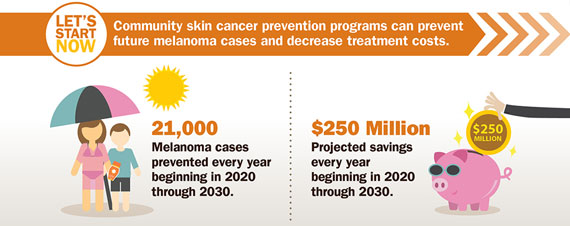Vital Signs: Preventing Melanoma
Communities Play a Vital Role
June 2015


9,000
More than 9,000 Americans die of melanoma each year.
2x
Rate of new cases of melanoma doubled from 1982 to 2011.
21,000
Using proven community prevention programs could avoid an estimated 21,000 new melanoma cases each year.
Skin cancer is the most common form of cancer in the US. In 2011, there were more than 65,000 cases of melanoma, the most deadly form of skin cancer. Melanoma can spread to other parts of the body and causes over 9,000 deaths every year. People who die of melanoma lose an average of 20 years of life expectancy. Melanoma can be caused by too much exposure to ultraviolet (UV) rays from sun or sources such as indoor tanning. Without additional prevention efforts, melanoma will continue to increase in the next 15 years. Communities and policy makers play a major role in these skin cancer prevention efforts.
Communities and policymakers can:
- Increase shade at playgrounds, public pools, and other public spaces.
- Promote sun protection in recreation areas, including the use or purchase of hats, sunscreen, and sunglasses.
- Encourage employers, childcare centers, schools, and colleges to educate employees and students about sun safety and skin protection.
- Restrict the availability and use of indoor tanning by minors.
Melanoma is increasing.
Melanoma skin cancer is common and costly.
- People of any skin color can get skin cancer and people with lighter skin are at higher risk.
- More than 65,000 melanoma skin cancers were diagnosed in the US in 2011.
- Melanoma can be disfiguring and even deadly; deaths increase with age and are higher for men than women.
- The annual cost for treating melanoma has grown faster than the annual treatment costs for all cancers combined.
- The annual cost of treating new melanoma patients is projected to triple from 2011 through 2030 (from $457 million to $1.6 billion).
- Using proven community skin cancer prevention programs could prevent an estimated 21,000 melanomas and save $250 million per year by 2030.
UV exposure causes more than 90% of melanomas in the US.
- Tans and sunburns are the body’s response to damage from UV exposure. A tan is a sign of damaged skin.
- More than 1 in 3 Americans report getting sunburned every year.
- Indoor tanning exposes people to more intense UV rays than the sun. About 6,200 melanomas are estimated to be caused each year by indoor tanning.
- Nearly 1 of 3 young non-Hispanic white women ages 16–25 uses indoor tanning each year.
Source: CDC Vital Signs, Morbidity and Mortality Weekly Report, June 2015.
Federal government is
- Requiring most health plans to cover recommended skin cancer prevention counseling at no out-of-pocket cost (such as co-pays or deductibles) through the Affordable Care Act.
- Requiring indoor tanning equipment to:
- Meet special requirements for how these devices are designed and made.
- Carry visible warning: people under age 18 should not use the device.
- Include warning statements in marketing materials about the risk of using the device.
Health care provider recommendations for skin cancer counseling
The US Preventive Services Task ForceExternal recommends that doctors and other health care providers counsel people ages 10–24 with fair skin about the dangers of UV rays and how to prevent skin cancer.
Communities and policymakers can
- Increase shade at playgrounds, public pools, and other public spaces.
- Promote sun protection in recreation areas, including the use or purchase of hats, sunscreen, and sunglasses.
- Encourage employers, childcare centers, schools, and colleges to educate employees and students about sun safety and skin protection.
- Restrict the availability and use of indoor tanning by minors.
Employers, childcare centers,schools, and colleges can
- Provide sun protection such as shade structures, sunscreen, and protective clothing for students and employees.
- Change policies that restrict sun protection, including school bans on wearing hats outdoors.
- Protect workers and students by scheduling activities before or after midday hours.
- Relocate activities and provide structures to increase shade when possible.
- Discourage indoor tanning and restrict its use on campuses.
Everyone can
- Understand that tanned skin is damaged skin.
- Protect themselves and their families by:
- Wearing a wide-brimmed hat, sunglasses, and protective clothing outdoors.
- Finding shade, especially during midday hours.
- Using broad-spectrum sunscreen with SPF 15 or higher, even on cloudy days. Sunscreen is most effective when used with other sun protection and reapplied as directed.
- Avoid sunbathing and indoor tanning.
The Guide to Community Preventive Services recommends community-wide programs that combine education, mass media campaigns, and policy changes to increase skin protection.
- Vital Signs Issue details: Melanoma Incidence and Mortality Trends and Projections — United States, 1982–2030, Morbidity and Mortality Weekly Report (MMWR)
- Vital Signs – Preventing Melanoma [PODCAST – 1:15 minutes]
- Vital Signs – Preventing Melanoma [PSA – 0:60 seconds]
- Preventing Skin Cancer: Findings of the Task Force on Community Preventive Services on Reducing Exposure to Ultraviolet Light
- The Guidelines for School Programs to Prevent Skin Cancer
- A Tan Is Not a Sign of Health: Sharon McKenna, Melanoma Survivor, Shares Her Story


